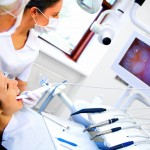
Traditionally caries detection and diagnosis in primary care has been carried out using a visual-tactile approach which may be supplemented by radiographs. This approach is believed to be successful at detecting caries that has progressed into dentine but not as effective as detecting early changes in dental enamel. Newer technologies such as fluorescence, transillumination, and electrical conductance devices may aid detection at this early enamel stage.
The main aim of this Cochrane review was to determine the diagnostic accuracy of different electrical conductance devices for the detection and diagnosis of non-cavitated coronal dental caries in different populations.
Methods
Searches were conducted in the Medline, Embase, US National Institutes of Health Ongoing Trials Register (ClinicalTrials.gov) and the World Health Organization International Clinical Trials Registry Platform databases. Diagnostic accuracy studies that compared electrical conductance devices with a reference standard of histology or an enhanced visual examination were considered. Two reviewers independently extracted data with sensitivity and specificity and 95% confidence intervals (CIs) were reported for each study. Coupled forest plots and summary receiver operating characteristic (SROC) plots, displaying the sensitivity-specificity points for each study were presented. Diagnostic accuracy was estimated using hierarchical summary receiver operating characteristic (HSROC) methods because of variability in thresholds.
Results
- 7 studies (719 tooth surfaces) with an overall caries prevalence of 73% were included.
- 4 studies (475 tooth surfaces) involved the electronic caries monitor (ECM) and 3 studies the CarieScan Pro (244 tooth surfaces).
- 6 studies used histology as the reference standard, one used an enhanced visual examination.
- No study was considered to be at low risk of bias across all four domains or low concern for applicability or both.
- In the individual studies, sensitivities ranged from 0.55 to 0.98 and specificities from 0 to 1.00. These extreme values of specificity may be explained by a low number of healthy tooth surfaces in the included samples.
- The diagnostic odds ratio (DOR) was 15.65 (95%CI; 1.43 to 171.15), and indicative of the variability in the included studies.
- Meta-regression showed no meaningful difference in accuracy according to device type or dentition but because of small number of studies other potential sources of heterogeneity could not be investigated.
- The certainty of the evidence was considered to be very low.
Conclusions
The authors concluded: –
The design and conduct of studies to determine the diagnostic accuracy of methods to detect and diagnose caries in situ is particularly challenging. The evidence base to support the detection and diagnosis of caries with electrical conductance devices is sparse. Newer electrical conductance devices show promise and further research at the enamel caries threshold using a robust study design to minimise bias is warranted. In terms of applicability, any future studies should be carried out in a clinical setting to provide a realistic assessment within the oral cavity where plaque, staining, and restorations can be problematic.
Comments
This new diagnostic test accuracy review of electrical conductance devices and has been undertaken following standard Cochrane Diagnostic Test Accuracy (DTA) and is one of a suite of reviews using the same generic protocol. Previous reviews have covered radiographs and imaging (Dental Elf – 19th Mar 2021), light-based tests (Dental Elf – 1st Feb 2021) and fluorescence devices (Dental Elf – 6th Jan 2021). Despite an extensive search only a small number of studies were identified providing very low certainty evidence. Consequently, there is little evidence to support its use in clinical practice at present. Any future studies should be carried out in realistic clinical situations well conducted and reported using the STARD checklist .
Links
Primary Paper
Macey R, Walsh T, Riley P, Glenny A-M, Worthington HV, Clarkson JE, Ricketts D. Electrical conductance for the detection of dental caries. Cochrane Database of Systematic Reviews 2021, Issue 3. Art. No.: CD014547. DOI: 10.1002/14651858.CD014547.
Other references
Cochrane Oral Health blog – Electrical conductance for the detection of early tooth decay
Dental Elf – 19th Mar 2021
Dental imaging methods for early caries detection and diagnosis
Dental Elf – 1st Feb 2021
Dental Elf – 6th Jan 2021
